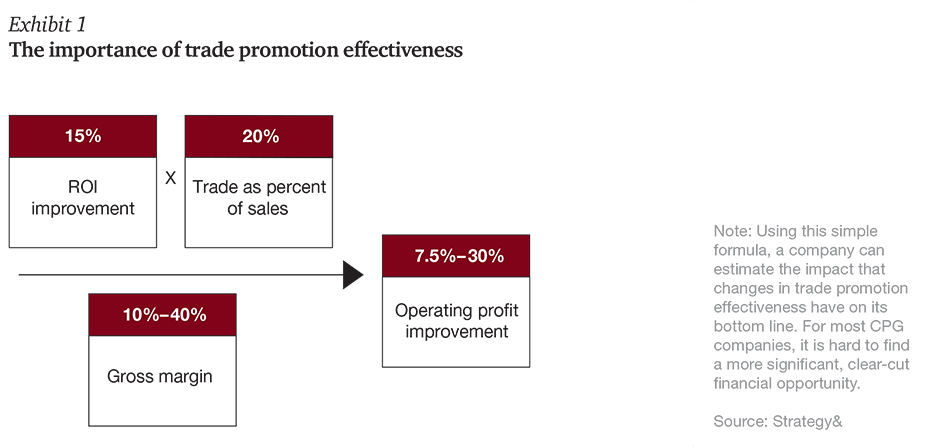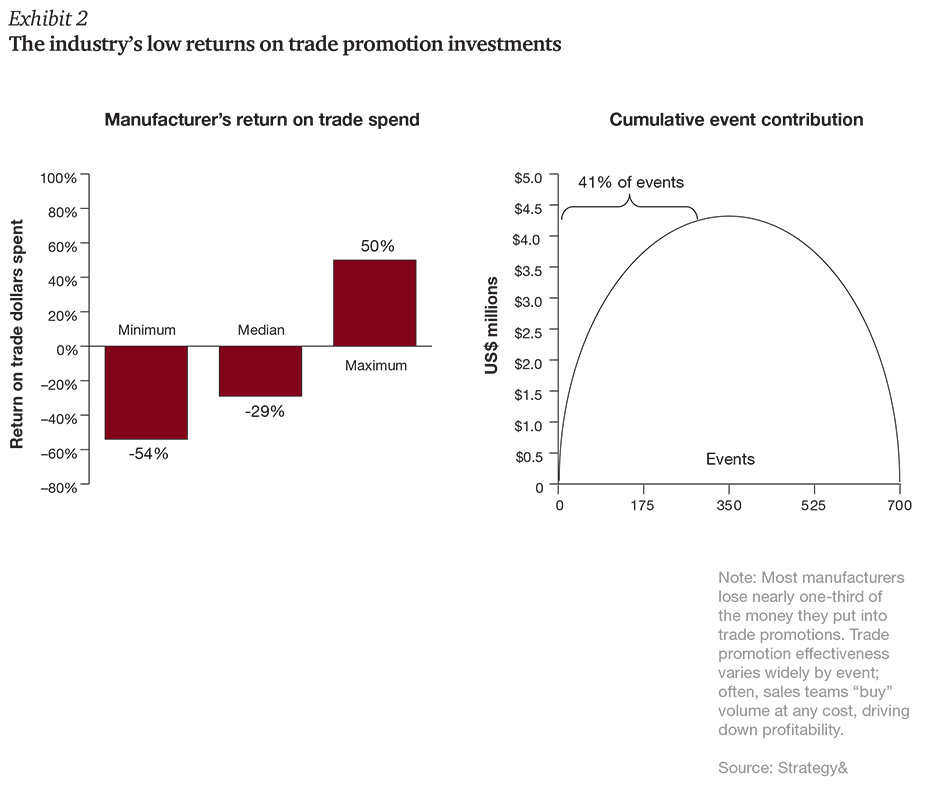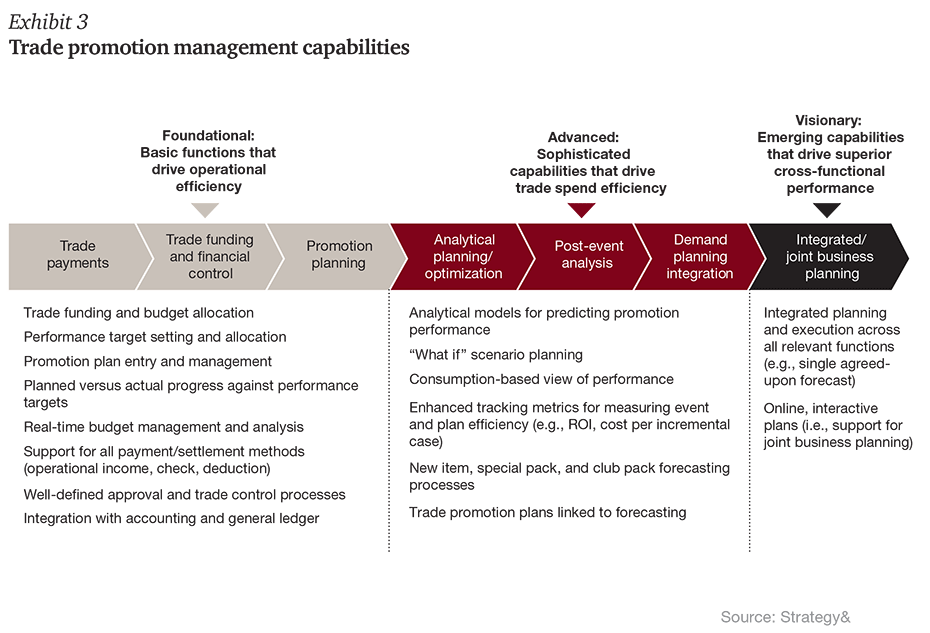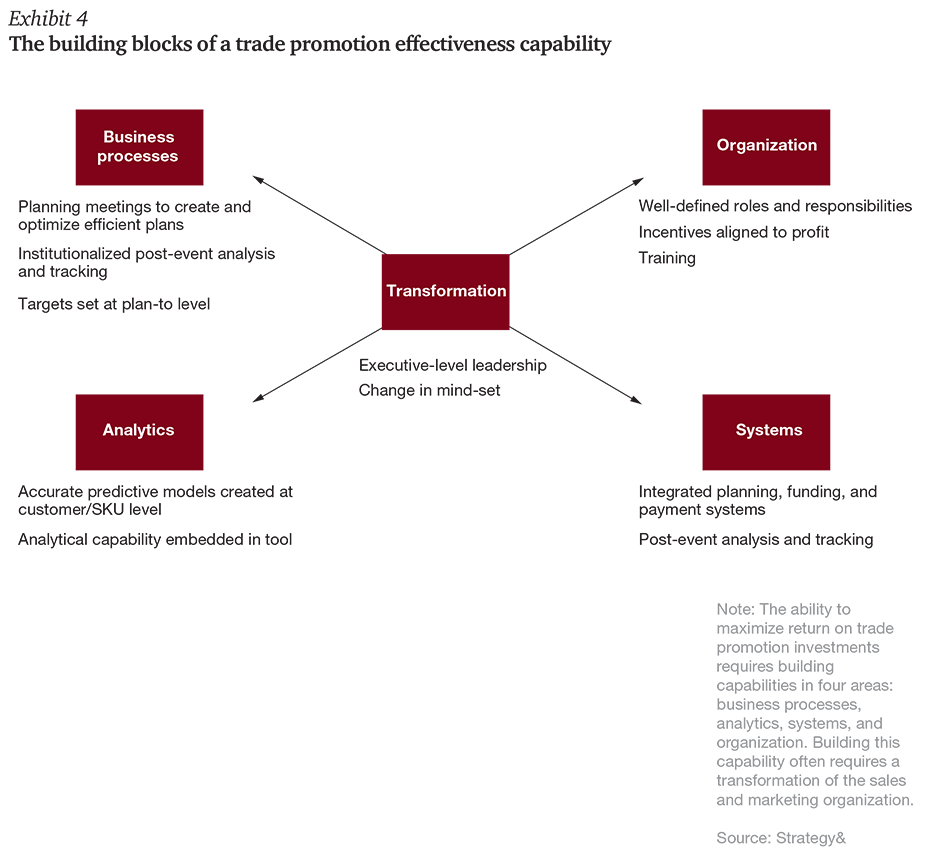Boosting the bottom line: Through improved trade promotion effectiveness
Boosting the bottom line through improved trade promotion effectiveness
Any discussion of collaboration between manufacturers and retailers would be incomplete without an examination of trade spending, a cash outlay that for manufacturers may account for as much as 25 percent of gross sales and is the second-largest item on the P&L, behind cost of goods sold. Leading companies embrace trade spending as a strategic investment but are increasingly funding consumer marketing, product customization, and value-added services as well. The goal is a collaboration between manufacturers and retailers to manage the trade-offs of investment decisions in a way that increases the return on the portfolio for both.
Although this shift to funding other initiatives expands companies’ options and may introduce changes in the overall marketing mix, it is not a panacea: Many companies continue to underleverage their investments in trade spending, despite its financial and strategic importance. However, trade promotion spending can be optimized in a way that transforms it from a drain on return on investment (ROI) to a significant bottom-line booster. Capitalizing on the opportunity requires an effort that integrates the appropriate analytics, systems, processes, and organizational capabilities in a way that focuses the entire sales organization on the bottom line.
Manufacturers of consumer packaged goods (CPG) can transform their sales organizations to drive profitable growth — often adding 10 to 15 percent to the bottom-line operating results on an ongoing basis — through improved trade promotion efficiency. The rewards can be significant: A 15 percent improvement in ROI has a major impact on the overall profit of the company (Exhibit 1).

Despite these encouraging numbers and the movement toward optimizing trade investments, however, the industry’s overall return on trade promotions is still disappointing. Many manufacturers are so focused on generating additional volume that the overall efficiency of their trade spending is low (Exhibit 2).

In fact, many companies cannot accurately and consistently distinguish between poorly performing promotions and more profitable ones. In a Strategy& survey, only 22 percent of companies could measure their trade spending at the individual event level.
Issues that impede trade promotion effectiveness
Many companies have attempted programs to improve trade promotion effectiveness, often investing millions in analyzing current performance and deploying systems with the hope of achieving step-change improvements. But in many cases, they have not taken the necessary steps to build an integrated program designed to deploy the proper capabilities in the right sequence. These programs often fail, leaving most account executives with little choice but to design and tailor promotions through some combination of intuition, experience, and custom-built spreadsheets. The first step in truly transforming a company’s trade promotion program is to identify and examine the factors that are inhibiting the current program’s success. These may include:
- Reliance on top-down rules. Certainly, not all guidelines should be eliminated: If properly developed, guidelines can drive a 2 to 4 percent increase in trade promotion efficiency. For example, one manufacturer of a highly perishable product was regularly running displays with deep discounts and having little success; consumers were simply unwilling to stock up on the product, no matter how good a deal they were offered, because the product had such a short shelf life. By removing the “deep discount” guideline and discontinuing the practice, the manufacturer saved nearly US$6 million a year. Typically, however, guidelines prevent only the most unproductive approaches and will not drive consistent efficiency improvements. Giving manufacturers and retailers flexibility on the ground is a better path to effective spending than insisting on rigid guidelines.
- Inability to understand promotion efficiency. Too often, companies cannot systematically distinguish between poorly performing promotions and more profitable ones. As a result, the companies are unable to allocate resources effectively among different promotions.
- Systems that lack robust analytical planning capabilities. Corporate systems — especially the major systems for customer relationship management (CRM) and enterprise resource planning (ERP) — do not have the analytical capabilities necessary for trade planning and optimization. Planning effectively and optimizing trade spending is a very complex task.
Most existing systems can serve as good control mechanisms, but they need to be customized or configured to handle effective analysis and planning.
- Inability to manage trade budgets easily. Many companies have virtually no insight into how their trade promotion budget is being spent, both on a company-wide and a brand-centric basis. This lack of financial understanding leads to a host of operational problems, from being unable to understand how much of the budget is left to invest to being unable to accurately account for open liabilities and actual spending. Given today’s strict accounting and control laws, many companies are spending hours manually collecting information from various sources to remain in compliance. These operational inefficiencies make it virtually impossible for sales teams to focus on building and selling more efficient events.
- Organizational focus on outdated metrics. Despite the increasing recognition that profitability should come before volume, the organizational structures of many manufacturers — from field sales to marketing — continue to focus on volume at all costs. But there is a world of difference between volume and profitable volume. By evaluating ROI, manufacturers can achieve growth in the most efficient way, but the profit mind-set must be embedded within all parts of the organization. To achieve this goal, successful organizations are increasingly using profit as a metric in their incentive and compensation structures.
- Lack of a comprehensive program. In some cases, companies have developed very strong capabilities in distinct areas, such as analytics, but they are not part of a comprehensive and synergistic program and thus fall victim to organizational inertia. To be effective, analytics and tools need to be linked effectively to changes in the trade promotion processes, including how events are planned, executed, and monitored.
Finding a better way
Despite the obstacles noted above, it is possible to change the way an organization designs and implements its trade programs. Although the tools and processes have been in place for more than 15 years, we strongly believe that success requires more than just models or tools. True transformation requires a fundamental, staged capability development for the company, driven by senior management and implemented at all levels of the organization. Success depends on a willingness to change the way an organization deploys its trade spending, gathers trade promotion data, and uses systems to analyze it. Analytics, systems, processes, and organization must be integrated to achieve a major transformation.
Strategy& has conducted in-depth trade promotion diagnostics for more than 20 CPG manufacturers. For each manufacturer, we created a database with several hundred promotional events. We found that the range in ROI between the worst and the best events for major manufacturers is negative 100 percent to more than 700 percent. Moreover, even at an account/brand level, the efficiency of the worst and best events typically ranges from 100 to 500 percent.
Why does event performance vary so widely? The account, promoted products, merchandising vehicles, pricing, timing, and financial terms all can, and often do, have a significant impact on a promotion’s ROI. Consider the following: Everyone knows that displays drive more volume than do features. But displays also cost much more than features, so displays are not necessarily more efficient than features. The efficiency of a potential promotion can be assessed only by weighing the expected consumer response against the expected cost of the promotion.
Even though event performance varies widely, it is highly predictable. Reliable and accurate statistical models for predicting the volumes of trade promotions for fast-moving consumer goods have been available for years. A good statistical model can usually predict the volume of an event with an average accuracy of plus or minus 5 to 10 percent. At this level of accuracy, the ROI for a single event can be predicted with an average accuracy of plus or minus 3 percent. Compared with the observed variability in event efficiency at the account/brand level, these statistical models, which can be built internally or outsourced from a number of providers, are highly accurate.
These two insights — that event performance varies widely and that it is nevertheless highly predictable — lead us to an important conclusion: Trade promotion investments can be optimized reliably by predicting performance for each individual event and selectively running more efficient events that succeed for both the manufacturer and the retailer.
Efficient events drive more volume, creating more funds for the retailer under an accrual system and thereby allowing the manufacturer to run more events with the retailer. There will be some friction in the system — e.g., “pet programs” that retailers insist on running at the manufacturer’s expense. However, these can often be accommodated in a balanced promotional portfolio.
The key to getting the benefits is to move the needle toward more efficient events. It doesn’t require running only events in the top quartile of efficiency. A company doesn’t even need to eliminate all the unprofitable events. Simply redirecting money from the bottom quartile to the median is sufficient to drive a 10 to 25 percent ROI improvement.
Trade promotion efficiency is a staged capability. For companies to capture the benefits of efficiency improvements, they must build a set of advanced trade promotion management capabilities. To be successful, these advanced capabilities must be built on top of a robust and reliable set of foundational capabilities (Exhibit 3).

Foundational. Foundational capabilities include all of the functions needed to fund, plan, and pay for a trade promotion — i.e., basic skills that any CPG company must have. These capabilities should be optimized for speed and efficiency, but they must be balanced against an appropriate set of spending controls to ensure compliance with finance and auditing procedures. Foundational capabilities are typically supported by and delivered through a company-wide CRM or ERP package. However, deploying foundational capabilities should not be considered an “out-of-the-box” implementation project. These capabilities must be carefully configured to meet the differing needs of manufacturers’ business strategies. Foundational capabilities must also be developed in a way that efficiently enables the launch of advanced capabilities.
Advanced. Advanced capabilities focus on analytics and enable decision making that improves trade spending efficiency. Analytical models are put in place to predict promotion performance and are accompanied by functions that enable scenario analysis. These capabilities also include post-event analysis that integrates events’ predicted performance with actual shipment, spending, and consumption information to provide feedback on actual event performance and efficiency. Advanced capabilities also allow trade plans, with accurate volume predictions, to be communicated to demand planning to assist in optimizing the supply chain and improving results through better retail delivery.
The importance of advanced capabilities is increasing as the level of detail available from operational point-of-sale data grows. With heightened levels of accuracy, companies can begin to create and respond to consumption-based demand needs on a store-by-store level. Leading companies are beginning to build the analytics required to leverage this information to improve spending efficiency even further.
Despite vendor claims, the major systems for customer relationship management and enterprise resource planning do not have the analytical horsepower necessary to deliver advanced capabilities. Companies that have successfully deployed these capabilities have done so with add-ons, niche packages, and other customized solutions.
Visionary. Visionary capabilities allow manufacturers to engage in joint business planning internally across all relevant functions, such as sales, marketing, operations, and finance, to develop a single agreed-upon forecast. Extending these capabilities to involve retailers makes trade promotion management holistic. The challenge of deploying visionary capabilities is redesigning the business to break down the traditional differences in mind-set and barriers to communication that commonly exist among various functions.
Many companies fall short of their potential because they attempt to deploy advanced capabilities without having a solid foundation. The results can be frustrating. For example, we often find tools that are configured to display advanced analytics such as ROI being deployed on top of a foundation that cannot accurately track information, producing incorrect results. Even worse, foundational capabilities are often inefficient, forcing users to spend hours simply entering and saving promotion plans. The message in building these capabilities, then, is “walk before you run.” Don’t start building out advanced or visionary capabilities without first putting in place the necessary foundational capabilities.
At the end of the day, optimizing the investment of several hundred million to several billion dollars in trade promotion is a critical organization capability for CPG manufacturers. The capability must be deployed using the right analytics, the right processes, the right systems, and the right organizational alignment (Exhibit 4).

Every organization must determine how best to build its trade promotion management capability. We have outlined the principles that underpin the business opportunity. These principles are universal, or nearly so. Unlike these principles, the manner in which the capability is implemented is highly dependent on the company.
Whether an organization uses a direct store delivery network, brokers, a direct sales force, or some mix will affect the data and the best method of control over planning and execution. In addition, a company’s software application portfolio and IT strategy will have a significant impact on how the company chooses to deploy an appropriate set of trade promotion tools and systems.
By building strong foundational functions for trade promotion management, companies can incorporate more sophisticated analytics that will allow them to drive spending effectiveness, superior crossfunctional performance, and joint business planning with their retail partners. For those that make the commitment, the rewards can be significant, tangible, and timely.


